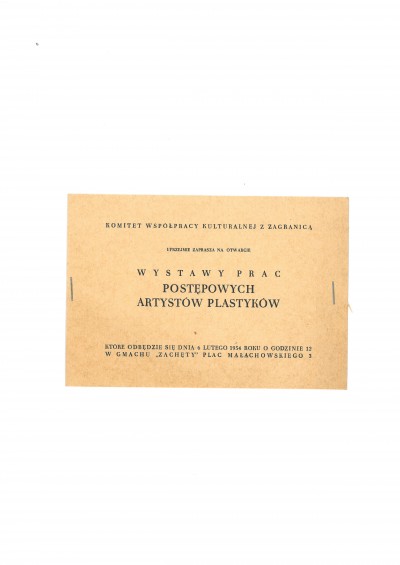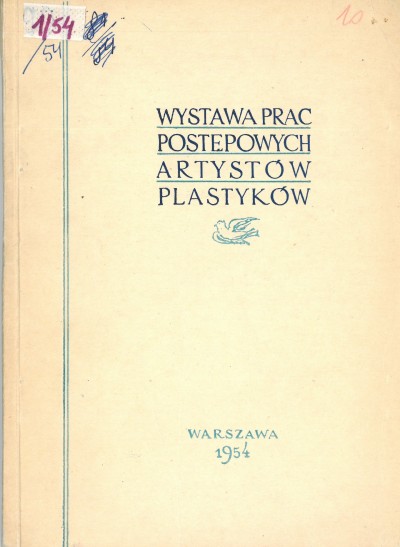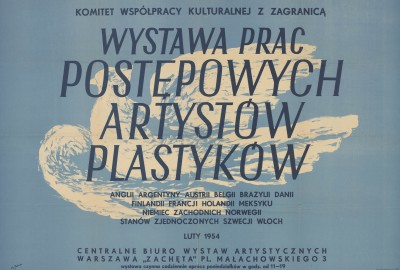Exhibition of works by progressive artists
06.02 – 05.03.1954 Exhibition of works by progressive artists
Zachęta Central Bureau of Art Exhibitions (CBWA)
organiser: Committee for Cultural Cooperation with Foreign Countries, Central Bureau of Art Exhibitions
attendance: 20,727
The Exhibition of Works by Progressive Visual Artists gathered about 400 graphics created by 140 artists from 15 countries outside the socialist bloc: Argentina, Austria, Belgium, Brazil, Denmark, Finland, France, the Netherlands, Mexico, West Germany, Norway, the United States of America, Sweden, the United Kingdom and Italy. It was the first time that the Central Bureau of Art Exhibitions presented works by artists from Argentina, Brazil and Norway.
In the introduction to the exhibition catalogue, Andrzej Jakimowicz wrote: ‘A clear connecting factor between the works collected here is the ideological issue, the issue of the artists’ attitude in the struggle for peace and social justice engulfing the whole world. This ideological and content criterion is a complete novelty in the field of international art exhibitions.1 Jakimowicz also added: ‘The selection of exhibited works was not governed by the categorical and rather vague notion of “artistic quality”. The exhibition features works by artists of worldwide renown, as well as pieces by largely unknown authors.2 Critics, however, pointed out the artistic value of the presented graphics. For example, Andrzej Wirth claimed that ‘at the forefront, we can see the undoubtedly magnificent woodcuts from Mexico and Brazil, Italian graphics, England with its Hogarth and, as always, the homeland of painters — France.3 Many pointed out that the Mexican artists’ works were dynamic and dramatic, while pieces created by Norwegians were calm and balanced.4
Norwegian art was appreciated by Jerzy Olkiewicz: ‘The Norwegian graphics are quite a surprise, since this seemingly sunless and grey country shows colourful, vivid woodcuts.’ The critic stressed that this was ‘the only group of works at the exhibition in which colour plays an integral role’. However, he criticised English, German and American works: ‘The English graphics are not distinguished by anything special. The English woodcut is conventional . . . A large number of works have been sent from West Germany and the United States, and it cannot be said that they are all of an adequate artistic quality.5
The aforementioned Jakimowicz pointed out that graphics, often having the character of political satire or caricature,6 are a traditional medium when it comes to expressing socially involved messages due to ease of reproduction. Barbara Olszewska wrote about it in a similar manner: ‘Progressive art readily uses graphics, which allows the artist to express themselves relatively quickly and to disseminate their works in large numbers.7
The artists presented at the exhibition were touted by Polish press as heroes, because — at least according to Andrzej Wirth — ‘an artist who dares to show a realistic landscape, evoking love of the homeland among the formalistic jumble of contemporary art production, performs a patriotic act by standing in opposition to the cosmopolitan gibberish’.8
The most interesting review, presenting the greatest understanding of the subject at hand was written by Jan Lenica, who spent time in London at the end of 1954 and created nine caricatures of the capitalist reality of the city.ix He wrote about the exhibition at Zachęta in the following terms: ‘However, this exhibition has a fault of another kind — it is incomplete, non-exhaustive, and an assessment of progressive art in capitalist countries (or art that is only just moving towards progressive attitudes) developed on the basis of the present exhibition, would not be entirely fair. The group of artists from the United States of America lacks one of the most interesting progressive painters and graphic artists — Ben Shahn, as well as another great painter depicting social issues — Joseph Hirsch. The Mexican Graphic Arts Studio is represented perhaps even too modestly, and some of the works are already well-known. The representation of the Italians seems to be quite random in its nature, while the South American group lacks Pablo Neruda, an excellent woodcutter, illustrator of Cando General.’x
The Polish audience had an opportunity to become acquainted with Mexican graphic artists in 1949 and 1950, when works from the Taller de Grafica Popular (Folk Graphics Studio) were exhibited in various Polish cities.xi Leopold Méndez visited Poland twice: as a delegate to the Congress of Intellectuals in Wrocław in 1948, and in 1952, on his way back from the Soviet Union.xii
The work of French and Italian left-wing artists was widely promoted during the period of Socialist Realism; this was connected not only with the long-term significance of France and Italy for Polish culture, but also with the strong position of communist parties in these countries. Involved French art was extensively presented at the 1952 Exhibition of Contemporary French Visual Arts at Zachęta. The criterion of ‘progressiveness’ was also applied during that exhibition — apart from artists of the renown of Pablo Picasso and Fernand Léger, it featured works by young Socialist Realists, whose names remained largely unknown to that date.
Poles already had an opportunity to get acquainted with the works by Paul Hogarth,xiii who attended the 2nd National Exhibition of Visual Arts as a guest.xiv Gazeta Krakowska wrote: ‘Hogarth has devoted many of his magnificent drawings to Poland, particularly to Warsaw, during his stay last year.’xv Hogarth was not only a graphic artist, but also a reporter and traveller. In 1936, he joined the British Communist Party and was a member of the International Brigades during the Spanish Civil War. In 1947, he spent time in Poland, in Silesia, where he worked for Coal magazine (National Coal Board). The next year, he attended the World Congress of Intellectuals in Defence of Peace in Wrocław, in 1950, he was a delegate to the World Congress of Partisans for Peace in Warsaw. In 1953, the International Press and Books Club hosted an exhibition of his works entitled Greece 1952.xvi
The Exhibition of Works by Progressive Visual Artists featured a very interesting set of graphics submitted by American artists. Barbara Olszewska pointed out: ‘It is no coincidence that a great number of works have been submitted by artists from the United States, although participation in this exhibition can be considered to be an act of courage. This is the first time we have seen so many of their works in Poland.’xvii Some graphics created in the United States were even exhibited anonymously — it can be assumed that their creators were afraid of persecution in their homeland. Ignacy Witz concluded that some works were exhibited anonymously ‘due to McCarthy’s terror that is prevalent there’.xviii This remark applies to the works by Ethel and Julius Rosenberg, who were sentenced to death in 1953 for espionage on behalf of the Soviet Union.xix Express Wieczorny pointed out, that ‘The accusatory accents against the racist American policy can be found in works by the majority of progressive visual artists from the United States.’xx The preserved source material — a text prepared for guides to the exhibition at Zachęta — provides us with the following commentary to the American works: ‘Despite the fact that the United States of America is a police state, in which every democratic thought is prosecuted by the House Committee on Un-American Activities, the collection from that country is extensive.’xxi The ranks of American artists whose works were exhibited included Charles White, an African-American Socialist Realist, who addressed the issue of racial segregation in the United States in his works.
The only American artist whose name was already known by the Polish audience, and who appeared among artists whose works were exhibited at the CBWA in 1954, was William Gropper, who spent time in Poland in 1949.xxii In 1950, a book by Derek Kartun entitled Migawki amerykańskie [This is America] with Gropper’s illustrations was published in Poland.xxiii Four years earlier, he published lithographs commemorating the victims of the Holocaust.xxiv In 1925, William Gropper started working at Morgen Freiheit, a newspaper founded by the Jewish section of the Communist Party of the United States of America.xxv In 1929, he was one of the founding members of the John Reed Club for artists and writers. It was a communist group, which gathered other active representatives of American Socialist Realism: Raphael Soyer and Louis Lozowick. These artists were members of anti-fascist Jewish groups active in the 1930s, such as the Yiddisher Kultur Farband.xxvi Gropper’s participation in the 1954 exhibition in Warsaw was an act of courage, since in 1953 he had been subpoenaed by the McCarthy’s committee, and his name was blacklisted.
The Exhibition of Works by Progressive Visual Artists might be considered a summary of the exhibition policy of the Committee for Cultural Cooperation with Foreign Countries towards artists from outside the Iron Curtain. It included almost all artists present in Polish exhibition halls in the first half of the 1950s. These works — apart from the works by Polish Socialist Realists — were also touted for their realistic character. ‘This exhibition shows that conveying the hot topics of one’s own protest or the fervour of one’s own faith can be achieved by the artist in the best way when they use an ambiguous, simple and clear language of realistic artistic expression.’xxvii
The exhibition was also shown in the National Museum in Poznań (21 March–16 April 1954) and in Jerka (25 April–5 May 1954).
Karolina Zychowicz
department of documentation of Zachęta — National Gallery of Art
This compilation was prepared as part of the National Programme for the Development of Humanities of the Polish Minister of Science and Higher Education — research project The History of Exhibitions at Zachęta — Central Bureau of Art Exhibitions in 1949–1970 (no. 0086/NPRH3/H11/82/2016) conducted by the Institute of Art History of the University of Warsaw in collaboration with Zachęta — National Gallery of Art.
Bibliography
Compilations:
- Kal, Elżbieta. „Tego się nie krytykuje, na kogo się nie liczy”. Polska krytyka artystyczna okresu realizmu socjalistycznego. Słupsk, 2010
- Zychowicz, Karolina. ‘The Exhibition-Organising Activity of the Comitee for Cultural Cooperation with Foreign Countries (1950–1956) Based on the Example of Selected Exhibitions at the Zachęta Central Bureau of Art Exhibitions’, trans. Klaudyna Michałowicz. Ikonotheka, no. 26, 2016, pp. 63–94
Source texts:
- Borowiak, Barbara. ‘Plastyka w walce o pokój i socjalizm’. Świetlica, no. 4, 1954, pp. 20–21
- Dekert, Franciszek. ‘Picasso, Hogarth i inni artyści plastycy w warszawskiej „Zachęcie”’. Express Szczeciński, no. 48, 1954
- ‘Dzieła sztuki walczącej na Wystawie Prac Postępowych Artystów Plastyków w Zachęcie’. Express Wieczorny, no. 32, 1954
- ‘Grafika brazylijska’. Świat, no. 14, 1954
- ‘Grafika Paula Hogartha’. Gazeta Krakowska, no. 38, 1954
- ‘Humanistyczna sztuka postępowych artystów zachodu’. Głos Koszaliński, no. 49, 1954
- Jakimowicz, Andrzej. [untitled], in Wystawa prac postępowych artystów plastyków, exh. cat. Warsaw: Zachęta Central Bureau of Art Exhibitions, 1954, pp. 3–6
- Jw. ‘400 prac postępowych twórców z krajów kapitalistycznych w salach warszawskiej „Zachęty”’. Sztandar Młodych, no. 36, 1954
- Kos. ‘Graficy 15 krajów’. Życie Warszawy, no. 33, 1954
- Kossakowski, Andrzej. ‘„Fachowa” recenzja’. Przegląd Kulturalny, no. 21, 1954
- Kossakowski, Andrzej. ‘Wystawa walczącej grafiki’. Żołnierz Polski, no. 5, 1954, p. 25
- L. ‘Wystawa prac postępowych plastyków’. Dziennik Bałtycki, no. 51, 1954
- L. ‘400 prac — 139 autorów’. Dziennik Polski (Kraków), no. 39, 1954
- L. G. ‘Wystawa walczącej sztuki’. Trybuna Ludu, no. 38, 1954
- Lenica, Jan. ‘Proste i okrężne drogi’. Przegląd Kulturalny, no. 7, 1954, p. 8
- ‘Leopold Mendez’. Gazeta Tarnowska, no. 57, 1954
- M. Z. ‘Wrażenia z trzech wystaw’. Głos Pracy, no. 88, 1954
- Olkiewicz, Jerzy. ‘Protest’. Dziś i Jutro, no. 9, 1954
- Olszewska, Barbara. ‘Humanistyczna sztuka postępowego Zachodu’. Gazeta Białostocka, no. 39, 1954
- Pasikowski, Tadeusz. ‘Wystawa sztuki walczącej’ [Wystawa Prac Postępowych Artystów Plastyków w Poznaniu]. Nowy Świat, no. 13, 1954, p. 1
- ‘Sztuka przyjaciół’. Po Prostu, no. 8, 1954
- Wirth, Andrzej. ‘Sztuka broniąca życia’. Sztandar Młodych, no. 44, 1954
- Witz, Ignacy. ‘Sztuka zrodzona z walki. 140 artystów z 15 krajów’. Życie Warszawy, no. 40, 1954
- ‘Wystawa grafiki artystów 15 narodów w warszawskiej „Zachęcie”’. Echo Krakowskie, no. 44, 1954
- ‘Wystawa grafiki brazylijskiej w Warszawie’. Dziennik Zachodni (Stalinogród), no. 36, 1954
- ‘Wystawa grafiki Europy Zachodniej’. Dziś i Jutro, no. 4, 1954
- ‘Wystawa prac plastyków z zagranicy’. Głos Pracy, no. 32, 1954
- ‘Wystawa prac postępowych artystów plastyków’. Ijdysze Szriften, March 1954
- ‘Wystawa prac postępowych artystów-plastyków’. Przegląd Artystyczny, no. 2, 1954, pp. 68–71
- ‘Wystawa w „Zachęcie”’. Słowo Polskie, no. 33, 1954
- ‘Wystawa prac postępowych artystów-plastyków z 15 krajów’. Trybuna Ludu, no. 36, 1954
- Z. K. ‘Wspólnym językiem mówią artyści piętnastu narodów. Wystawa grafiki w „Zachęcie”’. Express Wieczorny, no. 42, 1954
- ‘Z wystawy plastyków w stolicy’. Trybuna Mazowiecka, no. 35, 1954
- ‘Z wystawy prac postępowych artystów-plastyków’. Nowa Kultura, no. 7, 1954
- ‘Z wystawy postępowych artystów-plastyków’. Życie Literackie, no. 12, 1954
- ‘Z wystawy prac postępowych artystów plastyków w Warszawie’. Głos Koszaliński, no. 37, 1954
- ‘Z wystawy prac postępowych artystów plastyków w Warszawie’. Słowo Ludu (Kielce), no. 38, 1954
- ‘Z wystawy prac postępowych artystów plastyków w Warszawie’. Sztandar Ludu (Lublin), no. 38, 1954
Press mentions:
- Gazeta Poznańska, no. 37, 1954
- Kurier Szczeciński, no. 33, 1954
- Świat, no. 8, 1954
- Tygodnik Demokratyczny, no. 7, 1954
Other sources:
- Wystawa postępowych artystów plastyków, film documentation, National Film Archive —Audiovisual Institute
Artists
Ignacio Aguirre (1900–1990), Jean Amblard (1911–1989), Albin Amelin (1902–1975), Claudio Astrologo (1928), Ugo Attardi (1923–2006), Badmin A.R., C.J. Basart (1915–1991), Beta Bayens, Chris Beckman, Jo Beesan, Alberto Beltrán (1923–2002), May Bert, Edward Biberman (1904–1986), Herluf Bidstrup (1912–1988), Masike Braat, Ángel Bracho (1911–2005), Henk Broer (1904–1986), Ginette Cachin-Signac (1913–1980), Giovanni Capelli (1923), Dorothy Carr (1902–1986), Francis Carr (1919–2013), Geneviève Chapront (1909), Graciano Clavis, Yves Cognioul, Willy Colberg (1906–1992), Ernie Crichlow (1914–2005), Adelyne Cross-Eiksson (1905–1979), Louis Deltour (1927–1998), Henri Demarez, Jef Diederen (1920–2009), Diluck [Didier Geluck], Sheila Dorell (1918–2014), Fritz Düsing (1896–1965), Jean Effel (1908–1982), Ludvig Eikaas (1920–2010), Eva Fernandes, Henryk Finne (1898 –1972), Forces Murales, Michel de Gallard (1921–2007), Paul René Gauguin (1911–1976), Hugo Gellert (1892–1985), Sven Gronvail, William Gropper (1897–1977), Walter Gube (1908–1962), Robert Gwathmey (1903–1988), Nils Hahne, E. Heinke, Henk Henriët (1903–1945), Volker Detlef Heydorn (1920–2004), Paul Hogarth (1917–2001), Karol Hubbuch, Julius Hüther (1881–1954), Walter Iler, Bet Low (1924–2007), Georg Eisler (1928–1998), Ivar Ekelund (1908–2002), Jerker Eriksson, Kuno Haglund, Rudolf Haurzinger, A. Jagdenberg, Folke Johannson (1912), Stanley Kaplan (1925–2015), Renina Katz (1925), Helmut Kirchberger, Willi Kiwitz (1896–1978), Werner Koruhas, Hans Kralik (1900–1971), Abraham Krol (1919–2005), Gert Kuth, Helge Kühn Nielsen, Petrus [Piet] Landkroon (1907–1997), Marie-Anne Lansiaux (1910–1991), C. Lataster, Fernand Léger (1881–1955), Axl Leskoschek (1889–1976), Birgitta Liljeblad, John Lindbblom, Thord Lindblom, Björn Lindroth (1931–1999), Bernard Lorjou (1908–1986), Louis Lozowick (1892–1973), Egin Malmsten, Manuel Martins (1911–1979), Fritz Martinz (1924–2002), Frans Masereel (1889–1972), Henk Melgers [Hendrik-Johan Melgers] (1899–1973), Leopoldo Méndez (1902–1969), Lex Metz (1913–1986), Harmen Meurs [Hermanus] (1891–1964), Dore Meyre, Mireille Mialhe [Mireille Glodek] (1911–1989), Jean Milhau (1902–1985), Saro Mirabella (1914–1972), Jean [Louis] Mittelberg [albo Mitelle, pseudonim Tim] (1919–2002), Yvonne Mottet (1906–1968), Gabriele Mucchi (1899–2002), (Kurt Peiser (1887–1962), Pablo Picasso (1881–1973), Cândido Portinari (1903–1962), Everardo Ramirez (1906–1992), Anton Refregier (1905–1979), Philip Reisman (1904–1992), Marcel Roche (1890–1959), Suzanne Roger (1899–1986), Hilde Rubinstein (1904–1997), Knut Rumohr (1916–2002), Börje Sandelin (1926–1970), Andreas Schotel (1896–1984), Gérad Singer (1929–2007), Felix Splitter, Stajahy, Harry Sternberg (1904–2001), Heinrid Sussman, Ehren Svenolov (1927), Dick ten Hoedt (1933–2006), Tapio Tapiovaara (1908–1982), Boris Taslitzky (1911–2005), Otto Treumann (1919–2001), Anneke van der Feer (1902–1956), Jeanne Van Hall, Konrad Volkert (1906–1999), Felix Walner (1906–1981), Lynd Ward (1905–1985), Erich Wessel (1906–1985), Charles Wilbert White (1918–1979), Sigur Winge (1909–1970), Tono Zancanaro (1906–1985), Mitelle Zuka (1924)
Exhibition of works by progressive artists
06.02 – 05.03.1954
Zachęta Central Bureau of Art Exhibitions (CBWA)
pl. Małachowskiego 3, 00-916 Warsaw
See on the map



